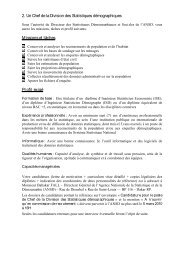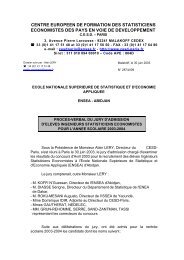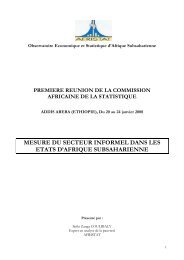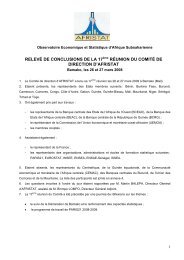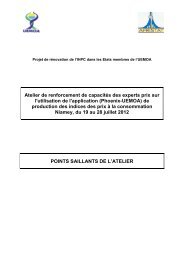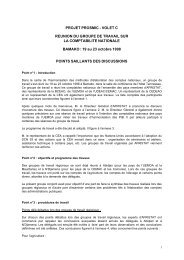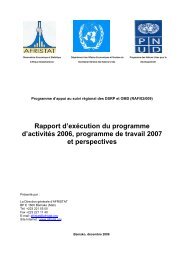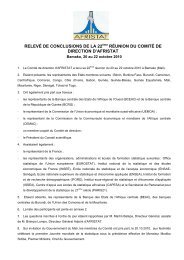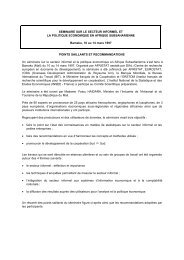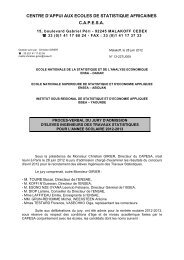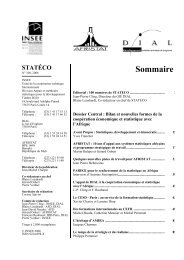Global Purchasing Power Parities and Real Expenditures - Afristat
Global Purchasing Power Parities and Real Expenditures - Afristat
Global Purchasing Power Parities and Real Expenditures - Afristat
Create successful ePaper yourself
Turn your PDF publications into a flip-book with our unique Google optimized e-Paper software.
Data Requirements 143ing the latter requirement proved to be difficult in manyeconomies. The special price collections for the ICP weregenerally run once in each quarter. In some cases, it was necessaryfor economies to collect prices monthly to preventbiases from price volatility during the quarter. An alternative,adopted by some economies for products whose priceswere highly seasonal, was to use price movements from thesame product (or product group) in the CPI to adjust theICP prices that were collected less frequently than thosein the CPI. This option was not available in all economiesbecause it requires having a sufficiently detailed <strong>and</strong> reliablemonthly CPI available.Calculating national average prices consistent with thenational accounts proved to be a difficult process, particularlyin very large economies. Generally, prices in rural areasare lower than those in urban centers, but collecting pricesin rural areas is more difficult <strong>and</strong> costly than collectingthem in towns <strong>and</strong> cities. Where it was not feasible to collectprices in both urban <strong>and</strong> rural areas, it was sometimespossible to use price information collected for other purposes.For example, rural <strong>and</strong> urban adjustment factors weresometimes applied to the prices collected in urban areas toimpute rural price levels. The urban <strong>and</strong> rural prices werethen combined (using weights derived from householdexpenditure surveys or other sources) to obtain a nationalaverage price. For many basic headings, the rural sector hadlittle impact on average prices, because the products or serviceswere only available in urban areas.Representativity <strong>and</strong> ComparabilityThe selection of the products to be priced affected theoutcome of the comparisons. The products to be priced byeach economy needed to meet two criteria: they shouldbe representative of its economy <strong>and</strong> comparable betweeneconomies. Conflicts arise because products that are mostrepresentative of a particular type of expenditure in oneeconomy are not necessarily identical to those in anothereconomy.In practice, there are significant differences in productspurchased within the same basic heading in different economies.And, of course, the proportions of total expenditurefor each basic heading differ between economies. Therefore,trade-offs were required to ensure that the productspriced were representative of the expenditures to whichthey related, as well as being comparable from one economyto another.The representative products of an economy are thosethat figure prominently in the expenditures within a basicheading. They may therefore be products that are frequentlypurchased by resident households <strong>and</strong> are likely tobe widely available throughout the economy. They may alsobe relatively high-value products that may not be boughtso frequently, but whose total value is a significant proportionof the total expenditure within a basic heading.With regard to comparability, products are said to becomparable if their physical <strong>and</strong> economic characteristicsare identical or they are so similar that consumers arehardly concerned about differences between them. In otherwords, a typical consumer is not prepared to pay more forone than the other. The main way in which comparabilitywas ensured was to prepare detailed specifications foreach product to be priced for the ICP in each region. However,another trade-off was involved in this process. On oneh<strong>and</strong>, a product selected for pricing in different economiescan be more accurately compared between economies ifthe specifications are tightly defined. On the other h<strong>and</strong>,the more tightly defined the product, the less likelihoodthere is of locating it in many economies.Product lists were constructed to provide the greatestpossible opportunity for economies to identify representativeproducts to price. No economy was expected to priceall the products within any particular basic heading. But alleconomies were expected to price at least some nonrepresentativeproducts so they could be matched with pricescollected in other economies.Price Data: Government FinalConsumption ExpenditureCompensation of employees in health, education, <strong>and</strong>general government is a major input to overall governmentPPPs. The compensation recorded for PPP purposesincluded basic salary <strong>and</strong> allowances before income taxes,in-kind payments (such as employer-subsidized housing),<strong>and</strong> actual <strong>and</strong> imputed social security contributions paidby the employer.



